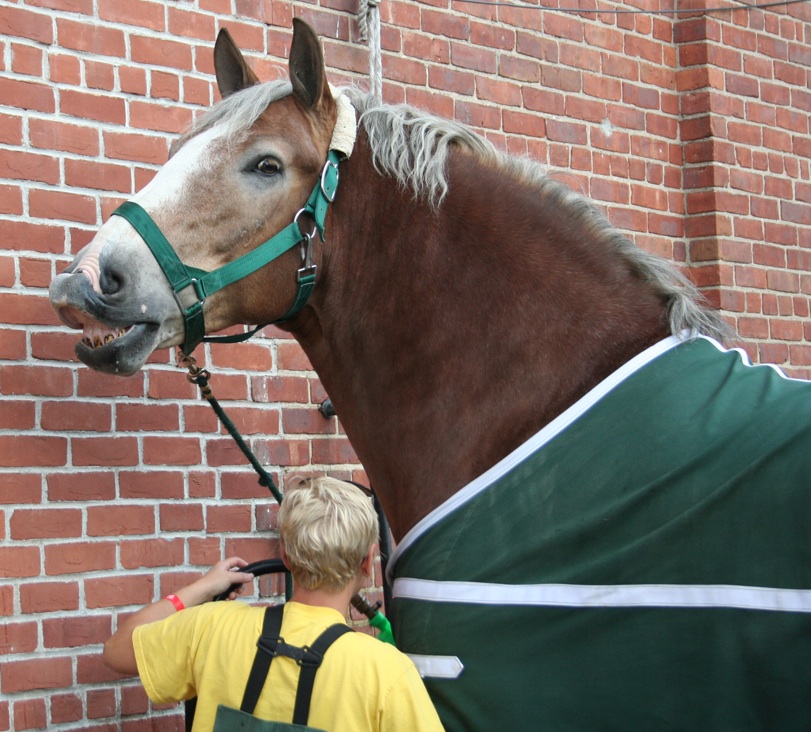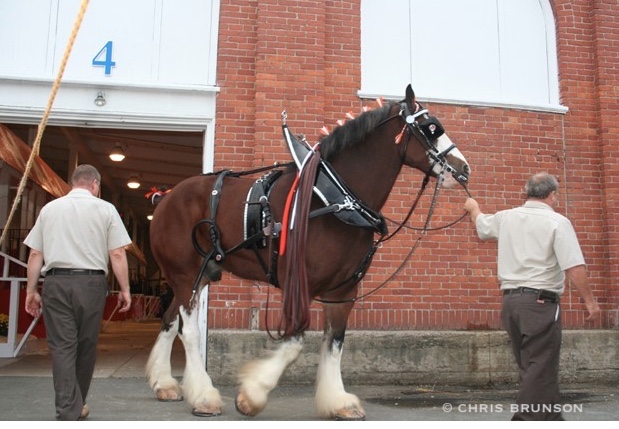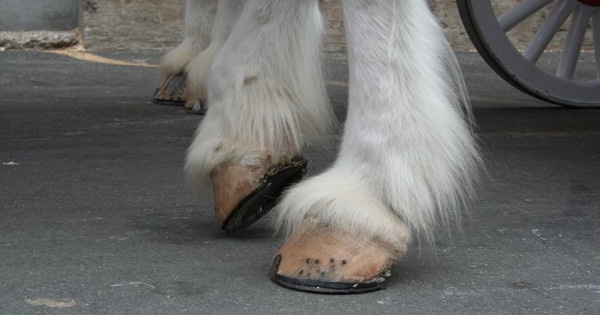Delicious Destination: The Big E Food Fair Fare; Plus Fetlocks, Forelocks
“Show me your horse, and I will tell you who you are.” –English proverb
The Big E is a festival fair that brings the Northeast's bounty and delights together in one sprawling place.
The legacy of Clydesdales at #TheBigE will be upheld by Hobby Knoll Stables following the retirement of the Hallamore Clydesdales hitch.
Witness the gentle giants daily in Farm-A-Rama and every evening at 6pm in The Big Parade, sponsored by @mgmspringfield! pic.twitter.com/3OSSWCxo9Y
— The Big E (@TheBigEFair) September 12, 2024
Wear comfortable shoes. Pick up an official guide (worth the small fee, but you can also just wander, ask people their favorites). Marvel over the gorgeous plantings, quiet beauty, blooms, foliage. Find us near the horses, livestock, honeybees exhibit, observing 4-H competition, noticing so much, acres to roam, sampling the foods. Yum, yum, yum.
Such as: Moolicious, Springfield Road, West Road, featuring The Moo Bomb, a customizable dessert experience of a waffle bowl filled with choice of soft serve ice cream, packed with fillings, and topped off with a hard candy shell; Cornbread Sundae a warm, homemade piece of cornbread topped with Sweet Corn Ice Cream, hot honey syrup and a dollop of whipped cream.
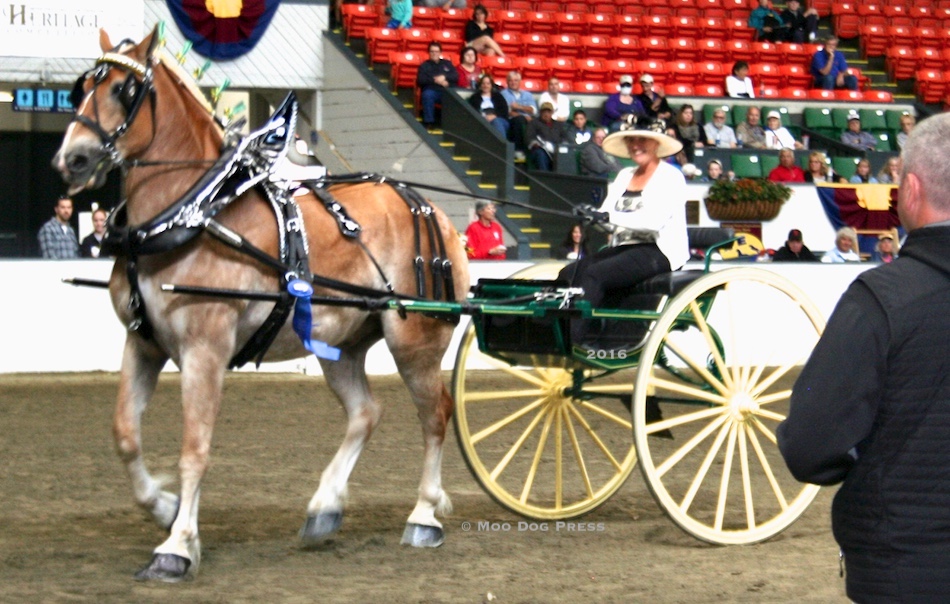
Equine events and the food, sights, sounds, Avenue of States at Eastern States Exposition, The Big E–2024 Sept. 13 to Sept. 29. Image inside the Coliseum competition, from the archives.
In 2009 (!), for the first time ever, watched the Clydesdales as these draft beauties were groomed, harnessed, hitched at the Farm-A-Rama building amid a crowd of onlookers. Unforgettable. Especially when glancing around to view the crowd that gathered. The artistry in a farrier's skill is evident in the workmanship displayed on each plate-sized hoof, every clinched nail.
From the well-soaped leather horse collars bright with metal trim to the polished hames and buckled girth – the rigging is performed calmly amid a sometimes noisy throng.
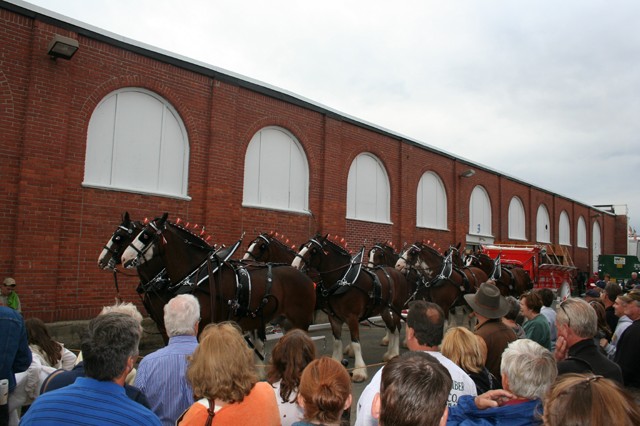
The Clydesdale, according to the Clydesdale Breeders of USA, is a breed of draft horse developed in the early 19th century by “farmers in the Clyde Valley of Lanarkshire (previously Clydesdale) district of Scotland . . . to meet not only the agricultural needs of local farmers, but also demands of commerce for coalfields and heavy haulage on the streets.” Today, this versatile breed, known for its high stepping gait while on parade, also performs under the saddle as a hunter-jumper, trail horse, and in dressage.
So why do these draft beauties have those white plumes of hair above their fetlocks? The feathers (the soft brush of hair where it goes over the hoof), originally helped protect the legs. Now it is primarily for show.”
The modern Clydesdale stands between 16 and 19 hands and weighs from 1,600 to 2,200 pounds. One “cardinal feature has been retained – the breed's substantial underpinning. The old adage ‘no foot-no horse' has always been true, thus the importance attached to maintaining sound hooves and legs within the breed.”
This experience is available to all who attend The Big E–and so much more. (Pickle fries; after getting on the grounds, heading out to find these!)
Here now is a slice of the tasty treats to sample, directly from the official site: When it comes to new foods, The Big E knows how to satisfy cravings, keep things fresh, and create over the top experiences. Whether we're bringing the new craze (yes, the pickle craze is here to stay) to fairgoers or spicing up classics, this year may be the best one yet. This year expect to find more than 75 new food items to excite and please your palate. Bring your appetite and be willing to sample some delicious and unique taste sensations.
New Food Vendors: The Deviled Egg, East Road: Specialty Deviled Eggs deep fried or regular, including Loaded Baked Potato Eggs, Taco Deviled Eggs, Pulled Pork Deviled Eggs, Dill Pickle Deviled Eggs and Breakfast Deviled Eggs.
Dragons Breath, Young Building: Nitro Ice Cream Swirls, Dragon Breath Puffs and a variety of delectable sauces and toppings.
Pickle Fries, East Road: Pickle Fries, Pickle Fries with Cheese n’ Gravy, Vegetarian Corndog and Corn Ribs.
Macho Taco, Commonwealth Avenue: Birria Vampiros, two birria tacos served with a side of dipping broth; Empanada Tacos, two empanadas cut open and filled with lettuce, pico, homemade lime aioli; Birria Raman, ramen noodles made with birria broth and birria meat; Mexican inspired Arepas; Horchata Agua Fresca, Mexican cinnamon and rice drink; and Watermelon Agua Fresca, fresh watermelon juice.
The Mick Express, Young Building: Grab-n-Go, Pizza, Daily Specials, Pasta Dishes, Local Coffee and Muffin Tops.
W.A.V.E. Mocktail Cart, The Front Porch: Kiwi Seltzer, P.O.G Juice, Virgin Mojito, 0.0% Spicy Margarita and Shirley Temple.
: – Pineapple, Lemon, Strawberry, Mango Flavors for the classic, whipped, frozen treat.
NOLA Cajun Kitchen and Raw Bar, New England Avenue: New Orleans inspired menu, including Maryland Cajun Crab Cakes, Fried Crawfish Tails, Jamaican Jerk Chicken served with Dirty Rice, Jambalaya, Beignets, Bread Pudding, and more.
Dribbles, Better Living Center: New England Coffee and fresh mini donuts made on site with four different Dribble sauces: Bavarian Cream, Strawberry Jam, Chocolate Sauce and Cinnamon Sugar.
The Nook, Better Living Center: Sweet and savory crepes with flavors like strawberry, banana and Nutella, plus ham and cheese, and spinach and cheese.
The Emporium, Better Living Center: Home of the reimagined Craz-E Burger, made with an Angus beef “smash burger” topped with cheese, bacon and onion rings and placed between two full, fresh glazed donuts. Plus, hamburgers, cheeseburgers, chicken fingers, hot dogs, crispy chicken wraps and more.
The Cantina, Better Living Center: Specialty cocktails including margaritas served with cotton candy on top, sangrias, and beer on draft.
The Wine Loft, Better Living Center: An intimate experience with a wide variety of wines offerings, and flights, paired with charcuterie platters. In partnership with Francis Ford Coppola Winery.
Oldies With New Goodies:
The Big E Bakery, New England Center, Avenue ShowPlace, Gate 9A: Cookies & Cream, filled with rich and creamy goodness, is the flavor of the year.
Schroder Concessions, Commonwealth Avenue: Various rotating flavored cheese curds in garlic, ranch, dill, jalapeño and Cajun.
Chompers, New England Avenue: Buffalo Chicken Chompers, crunchy balls of chicken, cheddar and mozzarella cheese smothered in Buffalo sauce. Served with Ranch dipping sauce.
Meatball Factory, Avenue of States: Korean Corn Dog.
LuAnn’s Bakery, New England Avenue: Maple Bacon Cupcake, Homemade Mini Apple Crisp Pies, Mini Fruits-of-the-Farm Crisp Pies, bottled lattes and cold brew.
Deliplace, East Road: Loaded Blooming Onion Ring.
West Springfield Lions Club, West Road: Grilled Chicken and Bacon Sandwich with ranch dressing and Grilled Chicken and Cheeseburger.
Cha Feo, Young Building: “Mochinut” (Japanese Donut).
Cinnamon Saloon, Hampden Avenue: Cherry and Apple Turnovers.
Jungle Juice Smoothies, Commonwealth Avenue: Luxury hot chocolate in assorted flavors.
Las Kangris, Young Building: Authentic, Puerto Rican Flan in vanilla, cheese, and piña colada.
Old Country Style Bavarian Nuts, New England Avenue: Mint Maple Iced Tea.
Veggie Patch, Commonwealth Avenue: Pickle Juice.
Deluca Family Foods, New England Avenue: Deep-Fried Ice Cream Sandwich
Hot Wisconsin Cheese, Springfield Road: Monstah Mozz on a stick – A single piece of hand-cut mozzarella cheese, deep fried on a stick. Crispy crunchy on the outside and ooey gooey in the middle.
Demetri’s, New England Avenue: Greek Fries.
Deep Fried Tacos, East Road: Mexican Rice Bowl with meat and taco toppings.
Poutine Gourmet, Springfield Road: Buffalo Chicken Poutine.
Storrowton Tavern, Avenue of States: Homemade Chocolate Chip Cookie Ice Cream Sandwich, Blackened Mac and Cheese Bowl, Cajun Mac and Cheese Bread Bowl, and Crab Dip.
New England Craft Beer Pub, Avenue of States: Pretzel Grillers, stuffed, grilled pretzel rolls, available in chicken, bacon, cheddar and ranch; pulled pork, bacon and cheddar; chicken, gorgonzola, cheddar and buffalo sauce; and corned beef, Swiss cheese, sauerkraut and thousand island dressing.
Ultimate BBQ, Food Court: Burnt Bacon Ends and Burnt Bacon Ends in Chocolate.
The Boot Scootin’ Saloon at Dolly’s Honky Tonk, Industrial Avenue: Pickled Eggs, Pickled Kielbasa and “Cowboy Nachos.”
The Indian Restaurant, Food Court: Gulab Jamun (Indian dessert).
Ferrindino Maple, Better Living Center, Springfield Road: Maple Coffee and Ferrindino Maple Creemee Cannoli, Italian cannolis filled with Ferrindino Maple Creemee and drizzled with Chocolate or Ferrindino Maple Syrup.
International Lobster House, West Road: Tater tots loaded with choice of lobster, pulled pork or bacon and cheese; and Jackalope Sausage.
The Clam Box, Food Court: Lobster Bisque, Fried Oysters and Oyster Tacos with Chipotle Coleslaw.
Hofbrahaus Bier Garden, Food Court: Goulash Stew.
All American Craft Beer Bar & Grill, Springfield Road: Polish God Father, caramelized onions, sautéed peppers, mustard and kielbasa on a pretzel roll.
Wurst Haus, Commonwealth Avenue: OG Schnitzel Sandy, pork cutlet breaded and fried until golden brown, topped Haus made sauerkraut and German beer mustard, served on a pretzel bun; and Supreme Schnitzel Sandy, pork cutlet breaded and fried until golden brown, topped with beer cheese sauce and bacon crumbles, served on a pretzel bun.
White Hut, Food Court: Quad Father Burger, four cheeseburger patties, four strips of bacon, pickles, house sauce and White Hut’s famous fried onions.
Harpoon Beer Hall, New England Avenue: Topped Breaded Pretzels; Plain Jane, classic salted with cheese dipping sauce; Pizza Party, salted and baked with garlic butter mozzarella and served with marinara dipping sauce; Gettin' Dilly with It, salted and baked with mozzarella bacon and pickles drizzled with ranch dressing; Hot Pepper, salted and baked with mozzarella, jalapeno peppers and scallions, served with cheese dipping sauce; Coco Loco, baked with cinnamon sugar, drizzled with chocolate sauce and topped with toasted coconut and whipped cream. Bang Bang Colossal Fried Shrimp, two golden fried beer battered skewered shrimp drizzled with bang bang sauce and topped with scallions; Big Shrimpin’ Colossal Fried Shrimp, two golden fried beer battered skewered shrimp served with tartar dipping sauce and fresh lemon; Aloha Colossal Fried Shrimp, two golden fried beer battered skewered shrimp drizzled with pineapple coconut sauce and topped with toasted coconut; Firecracker Colossal Fried Shrimp, two golden fried beer battered skewered shrimp drizzled with buffalo sauce and ranch; General Tso’s Colossal Fried Shrimp, two golden fried beer battered skewered shrimp drizzled with general Tso’s sauce and jalapeno.
The Hub, New England Avenue: Cajun Burger with a chorizo patty and beef patty topped with American cheese, grilled onions and homemade remoulade sauce.
Sam Adams Beer Garden, Avenue of States: Apple Cider Pulled Pork Grilled Cheese, on artisan sourdough, with a smoked pulled pork, Angry Orchard Crisp Apple Cider glaze, sharp cheddar cheese and fresh local apples; and Frozen Twisted Tea Rocket.
Kora’s Cookie Dough, Hampden Avenue: Birthday Cake Cookie Dough on a Stick.
Fluffy’s Hand-Cut Donuts, New England Avenue: Strawberry Lemonade Donut, hand-cut, yeast raised donut frosted with lemon buttercream frosting, rolled in strawberry lemonade crunch coating, topped with lemon gummy candy and a freeze-fried strawberry; Iced Coffee Glazed Donut Float consisting of a donut rim around an iced coffee with vanilla ice cream and a glazed donut hole.
Empanada Trailer, Industrial Road: Savory empanadas with beef, chicken or spinach; and sweet empanadas with Nutella or Dulce De Lecce.
Top The Crust, Food Court: Crab Rangoon Pizza.
Apple Fries, West Road: Peanut Butter, Bacon and Caramel Apple Fries Sundae.
Downeast Cider Garden, Outside the Young Building: Limited Edition Caramel Apple Cider, smooth caramel aroma, bright and refreshing apple flavor with a sweet caramel finish.
Chocolate Moonshine, Young Building: Experience the art of fudge-making as confectioners craft rich, velvety fudge right before your eyes—turning simple ingredients into an irresistible treat.
V-One Craft Cocktail Bar, New England Avenue: “Taylor’s Lavender Haze Lemonade” signature cocktail with V-One Lemon, organic lemonade, lavender simple syrup garnished with lemon and a sprig of lavender.
Editor's note: This story has been updated. As September is the season of spiders, asters, color in leaves changing, coming up soon another first, hiking to Spiderweed Preserve and wanting to know more about the artist who created this stone house, now a ruin.

